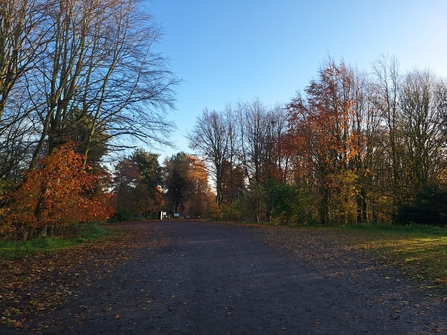
Warden's Work - Snipe Dales in November

I must start off by saying that after seeing the site visually change over the months, there is no time more beautiful at Snipe Dales than when Autumn has fully taken control of the reserve. I was greeted by a peppering of leaves on the floor of the car park as I arrived and the orange and reds of the leaves that remained intact had burst into life. The air was so still, and although the temperature had dropped, the calmness of the wind helped against the cold. I spoke to James on how the site had seemed reluctant to transition to autumn in October, but now the difference one month had made was incredible. He said that even working on the reserve every day, it had seemed that after waiting and waiting for it, autumn happened all at once. The beech trees had lost their leaves over the space of a weekend and the dominating green of the forest stepped aside for a range of shades of orange.
I was introduced to another regular volunteer this month, John. He has been volunteering at Snipe Dales for around 10 years and was a retired GP. It was amazing to see that someone from a completely different background can still find their way into this role, and I strongly recommend to anyone who is wanting to volunteer for the Trust to check out the roles we have on our website here: https://www.lincstrust.org.uk/volunteering-opportunities.
James informed me there would also be a tutor and a student working on a project on the reserve in the morning, as part of a regular visit they had been doing. The student had autism and struggled with mainstream education, but was thriving in this environment and approaching their learning in a different way. It was really powerful to me how nature can help someone engage with learning and progress in ways that a classroom has not been able to achieve. These spaces are so important for preserving wildlife, but also to us, and we must do all we can to protect them for future generations.
For our first major task of the day, John and I were working together on the Woodland Flora Project. It is a project around Snipe Dales based in the Country Park, where they have harvested seeds from remnant plants and grow them on and plant them out. Over the years they have put thousands out, working with what they have and building it up. We organised the pots into trays, and put them to the side as we gathered all of the ones that were ready to be taken out and planted. There were apparently over 30 different species of woodland plant just where we were working on.
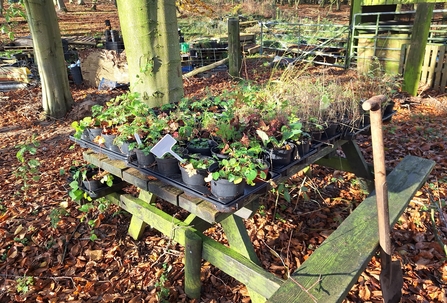
I am certainly no expert gardener but I must say how enjoyable and rewarding it was to take these pots and plant them around on the woodland floor. There were lots of factors to think about before planting though, something a man called Roy Harris had carefully planned out when he had started the project with James in 2012 just over 11 years ago. Different regions had different soil types and you had to carefully assess what plant did well in what conditions, with different amounts of light reaching different areas. I am excited to see Snipe Dales in the spring and compare the forest floor to what I have now become familiar with.
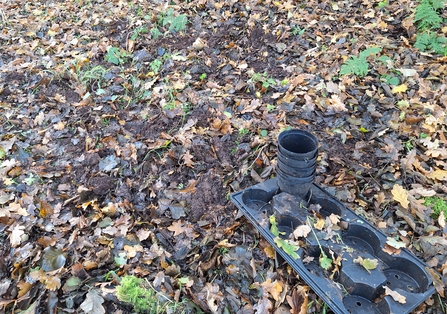
Once we had planted the pots, there was still a lot to organise around the area where the plants had been growing. Storm Babet had unfortunately washed a stream of water through the area, and there was lots of silt and broken pots that needed clearing out. We divided them into three sections: pots that still had soil and plants in; pots that were empty but could be reused and pots that were unfortunately too badly damaged from the storm. It may sound like a simple job, but with the sheer number we had to work through it ate into a lot of our time. It was great to see a completely different area of Snipe Dales than I have from my previous visits. It reinforces what James said from the last month that the focus has shifted from grassland the woodland management.
In the afternoon, I hung up my gardening gloves and helped James out with a more practical task of fixing a post of the fence that helps keeps deer from eating through all of woodland plants in that area. It was one of the first trial plots in Snipe Dales which stops deer from browsing and you can see the contrast between where they have browsed and where they can't get to. The fence was originally put up to protect the plants for the flora project and now just highlights the contrast. Once the post was in place, we headed back to James’ office where he needed to sharpen his chainsaw. It was great to get a tutorial on how to sharpen and tighten the chain – although I can’t imagine I’ll need to apply this new knowledge to anything any time soon!
James mentioned how Snipe Dales Country Park is a very young woodland, planted by the Forestry Commission in the 1960s, and that the woodland is quite bare. The reason for sharpening the chainsaw was that he was going to do something called thinning, which is the removal of some trees or parts of trees within a woodland. He explained that at around 10-15 years old, trees begin to compete for nutrients, space and the light, and the process of thinning can ensure that the best trees grow at the fastest rate, adding resilience to the woodland. The trees that are felled can also be left as dead wood which provides an important habitat for wildlife. It was more about managing the site for the next generations rather than fixing a current problem in the here and now. It was really interesting to hear James’ vision of the woodland and how what he is doing now will have beneficial effects for years to come.
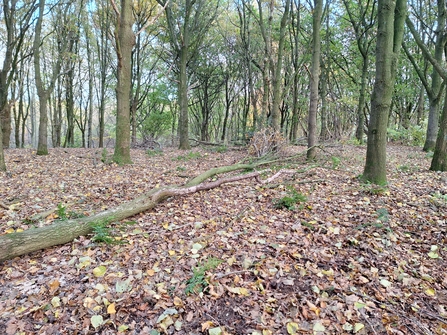
My visit this month concluded with a trip over to our Sow Dale reserve to speak with a contractor on how to make the site more accessible for James given the current weather conditions. I would find it hard to juggle all of the things happening on one site, let alone if I had multiple sites to worry about! But that is what it takes to be a Warden. It is almost as if you have to take a step back and see all the moving pieces in front of you rather than getting overwhelmed by what is going on right in the middle. The work that is being done is fantastic and evidence of it will hopefully be there for years to come.
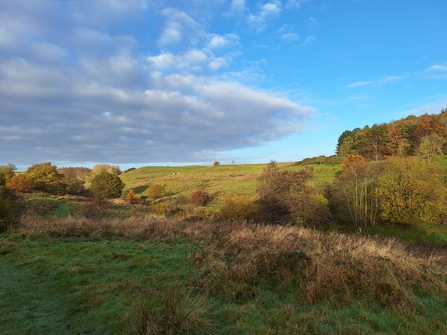
Snipe Dales in November

